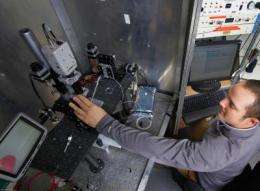New method monitors critical bacteria in wastewater treatment

(PhysOrg.com) -- Researchers have developed a new technique using sensors to constantly monitor the health of bacteria critical to wastewater treatment facilities and have verified a theory that copper is vital to the proper functioning of a key enzyme in the bacteria.
The new method senses minute changes in chemistry related to bacterial health and yields results immediately, unlike conventional technologies, which require laboratory analyses taking at least a day. This immediacy could make it possible to detect when bacteria are about to stop processing waste and correct the problem before toxins are released into waterways, said Eric McLamore, a postdoctoral research associate in civil engineering.
The technique also is a departure from conventional methods because established techniques require that bacterial "biofilms" be damaged or destroyed in order to be tested.
"It's important to monitor intact living specimens to obtain accurate data, and our approach is both non-invasive and a real-time technique," said Marshall Porterfield, an associate professor of agricultural and biological engineering.
Findings will be detailed in the Feb. 15 issue of the journal Biotechnology and Bioengineering. McLamore, Porterfield and M. Katherine Banks, head of the School of Civil Engineering and a professor of civil engineering, wrote the paper, which is being highlighted in the journal's "spotlight" section.
The biofilms are a matrix of wastewater-treatment organisms that coat natural or synthetic surfaces. A healthy population of the bacteria must be maintained for wastewater treatment facilities to operate properly, McLamore said.
The researchers used the method to study a type of bacterium called Nitrosomonas europaea. The microorganisms are referred to as nitrifying bacteria because they convert toxic ammonia from human wastes and fertilizer runoff into compounds called nitrites, which are further broken down by other bacteria into harmless nitrogen gas.
Sensor data reveal how well the bacteria are absorbing ions, or electrically charged atoms and molecules, from the wastes. The "filtering flux sensor" measures ammonia and nitrite to reveal the ion flux, or how many ions are being transported into and out of the biofilm per minute.
"When bacterial biofilms are poisoned, sick and stressed they start to release ions, including potassium and calcium, which is an early warning signal," Porterfield said. "The bacteria in wastewater treatment facilities often detach from surfaces, causing not only the loss of bacteria that are the foundation of the wastewater treatment system but also the uncontrolled flushing of untreated wastes into waterways.
"So if you can catch those signals, if you can detect those ions being released in real time you can develop a remediation strategy to note that they are stressed and try to get them back."
The sensor probe moves robotically back and forth every three seconds, enabling the device to capture data in two locations.
The method is called self-referencing because it compares the difference between measurements taken in two positions with the same sensor. Using a single sensor to constantly take measurements in two locations is critical for revealing rapid changes in concentration. Since individual sensors have slightly differing performance, comparing data from two different sensors does not yield precise results.
"This type of sensor isn't new, but the technique for using it is," McLamore said. "Sensors have never been used this way to measure biofilm ammonia and nitrite flux. Self referencing has been used in other applications but never in environmental studies."
The same method also could be used to monitor other bacteria and different ions.
"We can use this self-referencing method on many compounds that exist in liquids," McLamore said. "We are using this technique to monitor other ions produced by Nitrosomonas europaea and also by other species of bacteria. Real environments contain mixed cultures of all sorts of different bacteria species, and we want to use our method to monitor these."
A specific enzyme in Nitrosomonas europaea converts the ammonia to nitrite. The researchers used their new technique to verify a theory proposed decades ago that copper at the enzyme's "active site" where ammonia binds is critical to enabling the conversion.
The researchers tested the theory by using chemicals to repeatedly alter the copper to another form and then change it back to its normal state, effectively turning the bacteria on and off.
"There has been mostly speculation in the literature that copper was even at the site," Porterfield said. "So, by doing an experiment where we can turn biochemical switches on and off in the bacteria we have validated the fact that copper is indeed at the active site, while at the same time demonstrating the power of this monitoring technique."
The copper findings could lead to ways of enhancing wastewater treatment by adding or reducing copper concentration in response to changing conditions.
"There are probably also numerous applications for this technique besides wastewater treatment," McLamore said.
The research was conducted at the Bindley Bioscience Center in Purdue's Discovery Park. The system is being tested on bacteria grown in laboratory "bioreactors."
Source: Purdue University
















